Frye FP40D, FP40 User Manual

FONIX® FP40/FP40D
PORTABLE HEARING AID ANALYZER
OPERATOR’S MANUAL
A Note on this Manual
The instructions in this manual are for software version 3.70 and above, with references to earlier software. However, you may contact Frye Electronics for a more appropriate manual if you have earlier software.
Software Version 3.70 © September 2005 Frye Electronics, Inc.
Rev. Jun. 04, 2007 All Rights Reserved.

Table of Contents
Chapter 1: Introduction
1.1 Description . . . . . . . . . . . . . . . . . . . . . . . . . . . . . . . . . . . . . . . . . . . . . . . . . . . . . . . . 1
1.2 Hardware History . . . . . . . . . . . . . . . . . . . . . . . . . . . . . . . . . . . . . . . . . . . . . . . . . . . 1
1.3 Features & Options . . . . . . . . . . . . . . . . . . . . . . . . . . . . . . . . . . . . . . . . . . . . . . . . . . 2
1.3.1 Composite/Digital Speech Option . . . . . . . . . . . . . . . . . . . . . . . . . . . . . . . . . 2
1.3.2 Probe Option. . . . . . . . . . . . . . . . . . . . . . . . . . . . . . . . . . . . . . . . . . . . . . . . . . 3
1.3.3 External Video Monitor. . . . . . . . . . . . . . . . . . . . . . . . . . . . . . . . . . . . . . . . . . 3
1.3.4 Battery Pack Option . . . . . . . . . . . . . . . . . . . . . . . . . . . . . . . . . . . . . . . . . . . . 3
1.3.5 ID Option . . . . . . . . . . . . . . . . . . . . . . . . . . . . . . . . . . . . . . . . . . . . . . . . . . . . 4
1.3.6 RS232 Option . . . . . . . . . . . . . . . . . . . . . . . . . . . . . . . . . . . . . . . . . . . . . . . . . 4
1.3.7 OES (Occluded Ear Simulator) Option. . . . . . . . . . . . . . . . . . . . . . . . . . . . . . 4
1.3.8 CIC (Completely In the Canal) Option. . . . . . . . . . . . . . . . . . . . . . . . . . . . . . . 4
1.4 Accessories. . . . . . . . . . . . . . . . . . . . . . . . . . . . . . . . . . . . . . . . . . . . . . . . . . . . . . . . . 5
1.4.1 Standard Accessories . . . . . . . . . . . . . . . . . . . . . . . . . . . . . . . . . . . . . . . . . . . 5
1.4.2 Optional Accessories. . . . . . . . . . . . . . . . . . . . . . . . . . . . . . . . . . . . . . . . . . . . 6
1.4.3 Real-Ear Accessories . . . . . . . . . . . . . . . . . . . . . . . . . . . . . . . . . . . . . . . . . . . . 8
1.5 Layout & Controls . . . . . . . . . . . . . . . . . . . . . . . . . . . . . . . . . . . . . . . . . . . . . . . . . . 10
1.5.1 LCD (Liquid Crystal Display) . . . . . . . . . . . . . . . . . . . . . . . . . . . . . . . . . . . . 10
1.5.2 Front Panel Buttons . . . . . . . . . . . . . . . . . . . . . . . . . . . . . . . . . . . . . . . . . . . 11
1.5.3 Front Panel Lamps . . . . . . . . . . . . . . . . . . . . . . . . . . . . . . . . . . . . . . . . . . . . 11
1.5.4 Front Panel Knobs . . . . . . . . . . . . . . . . . . . . . . . . . . . . . . . . . . . . . . . . . . . . 12
1.5.5 Rear Panel Controls . . . . . . . . . . . . . . . . . . . . . . . . . . . . . . . . . . . . . . . . . . . 12
1.5.6 Right Side Mounted Jack and Module . . . . . . . . . . . . . . . . . . . . . . . . . . . . . 13
1.5.7 Sound Chamber Mounted Jacks and Controls . . . . . . . . . . . . . . . . . . . . . . . 13
1.5.8 Top of Instrument, Printer . . . . . . . . . . . . . . . . . . . . . . . . . . . . . . . . . . . . . . 13
1.6 FP40 Setup . . . . . . . . . . . . . . . . . . . . . . . . . . . . . . . . . . . . . . . . . . . . . . . . . . . . . . . 14
1.6.1 Setting up the instrument. . . . . . . . . . . . . . . . . . . . . . . . . . . . . . . . . . . . . . . 14
1.6.2 Connecting equipment . . . . . . . . . . . . . . . . . . . . . . . . . . . . . . . . . . . . . . . . . 14
1.6.3 Connecting the line cord. . . . . . . . . . . . . . . . . . . . . . . . . . . . . . . . . . . . . . . . 15
1.7 Miscellaneous . . . . . . . . . . . . . . . . . . . . . . . . . . . . . . . . . . . . . . . . . . . . . . . . . . . . . 15
1.7.1 Servicing Your FP40 . . . . . . . . . . . . . . . . . . . . . . . . . . . . . . . . . . . . . . . . . . . 15
1.7.2 Cleaning the FP40 Display . . . . . . . . . . . . . . . . . . . . . . . . . . . . . . . . . . . . . . 15
1.7.3 Emergency Shutdown. . . . . . . . . . . . . . . . . . . . . . . . . . . . . . . . . . . . . . . . . . 16
1.7.4 Warranty. . . . . . . . . . . . . . . . . . . . . . . . . . . . . . . . . . . . . . . . . . . . . . . . . . . . 16
Chapter 2: General Operation
2.1 Screen Navigation . . . . . . . . . . . . . . . . . . . . . . . . . . . . . . . . . . . . . . . . . . . . . . . . . . 17
2.2 General Setup Menu . . . . . . . . . . . . . . . . . . . . . . . . . . . . . . . . . . . . . . . . . . . . . . . . 17
2.2.1 Making selections . . . . . . . . . . . . . . . . . . . . . . . . . . . . . . . . . . . . . . . . . . . . 18
2.2.2 Saving changes . . . . . . . . . . . . . . . . . . . . . . . . . . . . . . . . . . . . . . . . . . . . . . . 18
2.2.3 Switching between partial and full menus . . . . . . . . . . . . . . . . . . . . . . . . . . 18
2.3 Using Function Keys . . . . . . . . . . . . . . . . . . . . . . . . . . . . . . . . . . . . . . . . . . . . . . . . 19
2.3.1 Hints. . . . . . . . . . . . . . . . . . . . . . . . . . . . . . . . . . . . . . . . . . . . . . . . . . . . . . . 19

2.3.2 Customizing the function keys . . . . . . . . . . . . . . . . . . . . . . . . . . . . . . . . . . . 20
2.4 Source Types . . . . . . . . . . . . . . . . . . . . . . . . . . . . . . . . . . . . . . . . . . . . . . . . . . . . . . 21 2.4.1 Understanding Pure-tone signals . . . . . . . . . . . . . . . . . . . . . . . . . . . . . . . . . 21 2.4.1.1 Pure-tone settings . . . . . . . . . . . . . . . . . . . . . . . . . . . . . . . . . . . . . 22 2.4.1.2 Noise Reduction. . . . . . . . . . . . . . . . . . . . . . . . . . . . . . . . . . . . . . . . . . . . . 22 2.4.1.3 Settling Time . . . . . . . . . . . . . . . . . . . . . . . . . . . . . . . . . . . . . . . . . 22 2.4.1.4 Harmonic Distortion . . . . . . . . . . . . . . . . . . . . . . . . . . . . . . . . . . . 23 2.4.2 Understanding Composite signals. . . . . . . . . . . . . . . . . . . . . . . . . . . . . . . . . 23
2.4.2.1 ICRA vs. ANSI . . . . . . . . . . . . . . . . . . . . . . . . . . . . . . . . . . . . . . . . . . . . . . 23 2.4.2.2 Noise Reduction. . . . . . . . . . . . . . . . . . . . . . . . . . . . . . . . . . . . . . . . . . . . . 24 2.4.2.3 Intermodulation Distortion . . . . . . . . . . . . . . . . . . . . . . . . . . . . . . . . . . . . 24 2.4.2.4 Composite source levels. . . . . . . . . . . . . . . . . . . . . . . . . . . . . . . . . . . . . . . 25
2.5 Display Mode. . . . . . . . . . . . . . . . . . . . . . . . . . . . . . . . . . . . . . . . . . . . . . . . . . . . . . 26 2.6 Battery Current Drain . . . . . . . . . . . . . . . . . . . . . . . . . . . . . . . . . . . . . . . . . . . . . . . 26 2.7 Using the DATA button . . . . . . . . . . . . . . . . . . . . . . . . . . . . . . . . . . . . . . . . . . . . . . 28 2.8 External Sound Chamber or Speaker. . . . . . . . . . . . . . . . . . . . . . . . . . . . . . . . . . . . 28
2.9 Printing . . . . . . . . . . . . . . . . . . . . . . . . . . . . . . . . . . . . . . . . . . . . . . . . . . . . . . . . . . 29 2.9.1 Selecting the printer . . . . . . . . . . . . . . . . . . . . . . . . . . . . . . . . . . . . . . . . . . . 29 2.9.2 Using the thermal printer . . . . . . . . . . . . . . . . . . . . . . . . . . . . . . . . . . . . . . . 29 2.9.3 Using an external printer . . . . . . . . . . . . . . . . . . . . . . . . . . . . . . . . . . . . . . . 30 2.9.4 Printing a label . . . . . . . . . . . . . . . . . . . . . . . . . . . . . . . . . . . . . . . . . . . . . . . 31
2.10 The Opening Screen . . . . . . . . . . . . . . . . . . . . . . . . . . . . . . . . . . . . . . . . . . . . . . . 32 2.11 The Battery Option (not available on FP40-D) . . . . . . . . . . . . . . . . . . . . . . . 32
Chapter 3: Coupler Measurements
3.1 The Main Coupler Screen . . . . . . . . . . . . . . . . . . . . . . . . . . . . . . . . . . . . . . . . . . . . 35 3.1.1 Viewing a Pure-tone display . . . . . . . . . . . . . . . . . . . . . . . . . . . . . . . . . . . . . 35 3.1.2 Viewing a Composite display . . . . . . . . . . . . . . . . . . . . . . . . . . . . . . . . . . . . 36
3.2 Leveling . . . . . . . . . . . . . . . . . . . . . . . . . . . . . . . . . . . . . . . . . . . . . . . . . . . . . . . . . 36 3.2.1 Leveling without the reference microphone (standard) . . . . . . . . . . . . . . . . 37 3.2.2 Leveling with the reference microphone. . . . . . . . . . . . . . . . . . . . . . . . . . . . 37 3.2.3 Saving the leveling information . . . . . . . . . . . . . . . . . . . . . . . . . . . . . . . . . . 38
3.3 Hearing Aid Setup . . . . . . . . . . . . . . . . . . . . . . . . . . . . . . . . . . . . . . . . . . . . . . . . . . 38 3.3.1 Setting up a BTE. . . . . . . . . . . . . . . . . . . . . . . . . . . . . . . . . . . . . . . . . . . . . . 39 3.3.2 Setting up an ITE/ITC/CIC. . . . . . . . . . . . . . . . . . . . . . . . . . . . . . . . . . . . . . 39 3.3.3 Setting up a body aid . . . . . . . . . . . . . . . . . . . . . . . . . . . . . . . . . . . . . . . . . . 41 3.3.4 Setting up an eyeglass aid . . . . . . . . . . . . . . . . . . . . . . . . . . . . . . . . . . . . . . 41
3.4 Frequency responses . . . . . . . . . . . . . . . . . . . . . . . . . . . . . . . . . . . . . . . . . . . . . . . . 42 3.4.1 Choosing a source type. . . . . . . . . . . . . . . . . . . . . . . . . . . . . . . . . . . . . . . . . 42 3.4.2 Taking the measurement. . . . . . . . . . . . . . . . . . . . . . . . . . . . . . . . . . . . . . . . 43 3.4.3 Viewing multiple measurements. . . . . . . . . . . . . . . . . . . . . . . . . . . . . . . . . . 44 3.4.4 Taking a single frequency response . . . . . . . . . . . . . . . . . . . . . . . . . . . . . . . . 44 3.4.5 Taking a three frequency average. . . . . . . . . . . . . . . . . . . . . . . . . . . . . . . . . 45

3.4.6 Viewing harmonic distortion. . . . . . . . . . . . . . . . . . . . . . . . . . . . . . . . . . . . . 45 3.4.7 Viewing battery current drain. . . . . . . . . . . . . . . . . . . . . . . . . . . . . . . . . . . . 46 3.4.8 Switching between gain and output . . . . . . . . . . . . . . . . . . . . . . . . . . . . . . . 46 3.4.9 Testing with the reference microphone. . . . . . . . . . . . . . . . . . . . . . . . . . . . . 46
3.5 Digital Aids. . . . . . . . . . . . . . . . . . . . . . . . . . . . . . . . . . . . . . . . . . . . . . . . . . . . . . . . 47 3.5.1 Testing with Digital Speech . . . . . . . . . . . . . . . . . . . . . . . . . . . . . . . . . . . . . 48 3.5.2 Testing with the Composite Signal . . . . . . . . . . . . . . . . . . . . . . . . . . . . . . . . 48 3.5.3 Testing with pure-tone sweeps . . . . . . . . . . . . . . . . . . . . . . . . . . . . . . . . . . . 49
3.6 Directional Hearing Aids . . . . . . . . . . . . . . . . . . . . . . . . . . . . . . . . . . . . . . . . . . . . . 49 3.6.1 Preparing for the measurement . . . . . . . . . . . . . . . . . . . . . . . . . . . . . . . . . . 50 3.6.2 Taking the Forward Measurement . . . . . . . . . . . . . . . . . . . . . . . . . . . . . . . . . 50 3.6.3. Taking the Reverse Measurement . . . . . . . . . . . . . . . . . . . . . . . . . . . . . . . . . 51
3.7 The CIC Option . . . . . . . . . . . . . . . . . . . . . . . . . . . . . . . . . . . . . . . . . . . . . . . . . . . . 52 3.8 The OES Option. . . . . . . . . . . . . . . . . . . . . . . . . . . . . . . . . . . . . . . . . . . . . . . . . . . . 53
Chapter 4: Automated Test Sequences
4.1 ANSI S3.22-2003 . . . . . . . . . . . . . . . . . . . . . . . . . . . . . . . . . . . . . . . . . . . . . . . . . . . 55 4.1.1 Setting up the aid for testing . . . . . . . . . . . . . . . . . . . . . . . . . . . . . . . . . . . . 56 4.1.2 Setting up the analyzer for testing . . . . . . . . . . . . . . . . . . . . . . . . . . . . . . . . 56 4.1.3 Running the test sequence . . . . . . . . . . . . . . . . . . . . . . . . . . . . . . . . . . . . . . 58 4.1.4 Viewing the results . . . . . . . . . . . . . . . . . . . . . . . . . . . . . . . . . . . . . . . . . . . . 58
4.2 ANSI S3.22-1996. . . . . . . . . . . . . . . . . . . . . . . . . . . . . . . . . . . . . . . . . . . . . . . . . . . 59 4.2.1 Setting up the aid for testing . . . . . . . . . . . . . . . . . . . . . . . . . . . . . . . . . . . . 59 4.2.2 Setting up the analyzer for testing . . . . . . . . . . . . . . . . . . . . . . . . . . . . . . . . 60 4.2.3 Running the test sequence . . . . . . . . . . . . . . . . . . . . . . . . . . . . . . . . . . . . . . 61 4.2.4 Viewing the results . . . . . . . . . . . . . . . . . . . . . . . . . . . . . . . . . . . . . . . . . . . . 62
4.3 ANSI S3.22-1987. . . . . . . . . . . . . . . . . . . . . . . . . . . . . . . . . . . . . . . . . . . . . . . . . . . 63 4.3.1 Setting up for the test. . . . . . . . . . . . . . . . . . . . . . . . . . . . . . . . . . . . . . . . . . 63 4.3.2 Running the test sequence . . . . . . . . . . . . . . . . . . . . . . . . . . . . . . . . . . . . . . 64 4.3.3 Viewing the results . . . . . . . . . . . . . . . . . . . . . . . . . . . . . . . . . . . . . . . . . . . . 64
4.4 ANSI S3.42-1992. . . . . . . . . . . . . . . . . . . . . . . . . . . . . . . . . . . . . . . . . . . . . . . . . . . 65 4.4.1 Setting up for the test. . . . . . . . . . . . . . . . . . . . . . . . . . . . . . . . . . . . . . . . . . 66 4.4.2 Running the test sequence . . . . . . . . . . . . . . . . . . . . . . . . . . . . . . . . . . . . . . 66 4.4.3 Viewing the results . . . . . . . . . . . . . . . . . . . . . . . . . . . . . . . . . . . . . . . . . . . . 67
4.5 IEC. . . . . . . . . . . . . . . . . . . . . . . . . . . . . . . . . . . . . . . . . . . . . . . . . . . . . . . . . . . . . . 67 4.5.1 Setting up the aid for testing . . . . . . . . . . . . . . . . . . . . . . . . . . . . . . . . . . . . 67
4.5.2 Setting up the analyzer for testing. . . . . . . . . . . . . . . . . . . . . . . . . . . . . . . . . . . . . . . 68
4.5.3 Running the test sequence . . . . . . . . . . . . . . . . . . . . . . . . . . . . . . . . . . . . . . 69 4.5.4 Viewing the results . . . . . . . . . . . . . . . . . . . . . . . . . . . . . . . . . . . . . . . . . . . . 69
4.6 Profiler. . . . . . . . . . . . . . . . . . . . . . . . . . . . . . . . . . . . . . . . . . . . . . . . . . . . . . . . . . . 70 4.6.1 Setting up for the test. . . . . . . . . . . . . . . . . . . . . . . . . . . . . . . . . . . . . . . . . . 70 4.6.2 Running the test sequence . . . . . . . . . . . . . . . . . . . . . . . . . . . . . . . . . . . . . . 71 4.6.3 Viewing the results . . . . . . . . . . . . . . . . . . . . . . . . . . . . . . . . . . . . . . . . . . . . 71
4.7 ACIC . . . . . . . . . . . . . . . . . . . . . . . . . . . . . . . . . . . . . . . . . . . . . . . . . . . . . . . . . . . . 72

Chapter 5: Real-Ear Measurements
5.1 Preparation for Real-Ear Measurements . . . . . . . . . . . . . . . . . . . . . . . . . . . . . . . . . 73 5.1.1 Setting up the analyzer for testing . . . . . . . . . . . . . . . . . . . . . . . . . . . . . . . . 73 5.1.1.1 To set up the microphones and monitor headset. . . . . . . . . . . . . . . . . . . . 73 5.1.1.2 To set up the internal sound field speaker. . . . . . . . . . . . . . . . . . . . . . . . . 74 5.1.1.3 To set up an external sound field speaker . . . . . . . . . . . . . . . . . . . . . . . . . 76 5.1.2 Setting up the client for testing . . . . . . . . . . . . . . . . . . . . . . . . . . . . . . . . . . 76 5.1.2.1 To position the sound field speaker . . . . . . . . . . . . . . . . . . . . . . . . . . . . . . 76 5.1.2.2 To place the earhook and reference microphone. . . . . . . . . . . . . . . . . . . . 77
5.1.2.3 To insert the probe tube. . . . . . . . . . . . . . . . . . . . . . . . . . . . . . . . . 78 5.1.2.4 To level the sound field . . . . . . . . . . . . . . . . . . . . . . . . . . . . . . . . . . . . . . . 79
5.2 The Target Screen . . . . . . . . . . . . . . . . . . . . . . . . . . . . . . . . . . . . . . . . . . . . . . . . . . 80 5.2.1 Viewing the target screen . . . . . . . . . . . . . . . . . . . . . . . . . . . . . . . . . . . . . . . 80 5.2.2 Creating a target. . . . . . . . . . . . . . . . . . . . . . . . . . . . . . . . . . . . . . . . . . . . . . 83 5.2.3 Setting the default target . . . . . . . . . . . . . . . . . . . . . . . . . . . . . . . . . . . . . . . 84 5.2.4 Creating your own target . . . . . . . . . . . . . . . . . . . . . . . . . . . . . . . . . . . . . . . 85 5.2.5 Modifying an existing target. . . . . . . . . . . . . . . . . . . . . . . . . . . . . . . . . . . . . 85
5.3 Insertion Gain Measurements . . . . . . . . . . . . . . . . . . . . . . . . . . . . . . . . . . . . . . . . . 85 5.3.1 Viewing the Insertion Gain screen . . . . . . . . . . . . . . . . . . . . . . . . . . . . . . . . 86 5.3.2 Taking an unaided response . . . . . . . . . . . . . . . . . . . . . . . . . . . . . . . . . . . . . 86 5.3.3 Taking an aided response . . . . . . . . . . . . . . . . . . . . . . . . . . . . . . . . . . . . . . . 87 5.3.4 Viewing insertion gain . . . . . . . . . . . . . . . . . . . . . . . . . . . . . . . . . . . . . . . . . 88 5.3.5 Testing Open Fit Hearing Aids . . . . . . . . . . . . . . . . . . . . . . . . . . . . . . . . . . . 89
5.4 SPL Measurements (including real-ear DSL) . . . . . . . . . . . . . . . . . . . . . . . . . . . . . . 90 5.4.1 Understanding the SPL approach . . . . . . . . . . . . . . . . . . . . . . . . . . . . . . . . . 90 5.4.2 Understanding the specifics of DSL . . . . . . . . . . . . . . . . . . . . . . . . . . . . . . . 91 5.4.3 Viewing the SPL screen. . . . . . . . . . . . . . . . . . . . . . . . . . . . . . . . . . . . . . . . . 92 5.4.4 Taking the SPL measurements . . . . . . . . . . . . . . . . . . . . . . . . . . . . . . . . . . . 92
5.5 Audibility Index (AI) . . . . . . . . . . . . . . . . . . . . . . . . . . . . . . . . . . . . . . . . . . . . . . . . 94 5.5.1 Viewing the AI display . . . . . . . . . . . . . . . . . . . . . . . . . . . . . . . . . . . . . . . . . 95 5.5.2 Performing AI measurements . . . . . . . . . . . . . . . . . . . . . . . . . . . . . . . . . . . . 96
5.6 DSL Coupler Measurements . . . . . . . . . . . . . . . . . . . . . . . . . . . . . . . . . . . . . . . . . . . 96 5.6.1 Performing the RECD measurement . . . . . . . . . . . . . . . . . . . . . . . . . . . . . . . 96 5.6.1.1 To perform the coupler measurement . . . . . . . . . . . . . . . . . . . . . . . . . . . . 97 5.6.1.2 To perform the real-ear measurement . . . . . . . . . . . . . . . . . . . . . . . . . . . . 98 5.6.2 Performing coupler measurements to a DSL target . . . . . . . . . . . . . . . . . . 100
5.7 Coupler prescription (non DSL) . . . . . . . . . . . . . . . . . . . . . . . . . . . . . . . . . . . . . . 101 5.7.1 Viewing the Target 2-cc screen . . . . . . . . . . . . . . . . . . . . . . . . . . . . . . . . . . 102 5.7.2 Taking the FOG measurement . . . . . . . . . . . . . . . . . . . . . . . . . . . . . . . . . . 103 5.7.3 Viewing the SSPL 90 screen . . . . . . . . . . . . . . . . . . . . . . . . . . . . . . . . . . . . 103 5.7.4 Taking the SSPL 90 measurement . . . . . . . . . . . . . . . . . . . . . . . . . . . . . . . 104 5.7.5 Checking an aid against a prescription. . . . . . . . . . . . . . . . . . . . . . . . . . . . 105 5.7.6 Accounting for venting effects . . . . . . . . . . . . . . . . . . . . . . . . . . . . . . . . . . 106 5.7.7 Understanding the technical details . . . . . . . . . . . . . . . . . . . . . . . . . . . . . . 106

5.8 Miscellaneous . . . . . . . . . . . . . . . . . . . . . . . . . . . . . . . . . . . . . . . . . . . . . . . . . . . . 107 5.8.1 Single frequency response . . . . . . . . . . . . . . . . . . . . . . . . . . . . . . . . . . . . . 107 5.8.2 Smoothing . . . . . . . . . . . . . . . . . . . . . . . . . . . . . . . . . . . . . . . . . . . . . . . . . 107 5.8.3 Reset Level . . . . . . . . . . . . . . . . . . . . . . . . . . . . . . . . . . . . . . . . . . . . . . . . . 108 5.8.4 Data Display . . . . . . . . . . . . . . . . . . . . . . . . . . . . . . . . . . . . . . . . . . . . . . . . 108
5.9 Body, CROS, and BI-CROS aids . . . . . . . . . . . . . . . . . . . . . . . . . . . . . . . . . . . . . . . 109 5.9.1 Testing body aids . . . . . . . . . . . . . . . . . . . . . . . . . . . . . . . . . . . . . . . . . . . . 109 5.9.2 Testing CROS and BICROS aids . . . . . . . . . . . . . . . . . . . . . . . . . . . . . . . . . 110 5.9.2.1 Head-Baffle Effect . . . . . . . . . . . . . . . . . . . . . . . . . . . . . . . . . . . . 110 5.9.2.2 How Well the Aid Overcomes the Head-Baffle Effect. . . . . . . . . . 111 5.9.2.3 Overall Insertion Gain . . . . . . . . . . . . . . . . . . . . . . . . . . . . . . . . . . . . . . 112 5.9.2.4 Insertion Loss to the “Good” Ear (CROS) . . . . . . . . . . . . . . . . . . . . . . . . 113
5.10 FM Systems . . . . . . . . . . . . . . . . . . . . . . . . . . . . . . . . . . . . . . . . . . . . . . . . . . . . . 114
5.11 Testing Directional Aids . . . . . . . . . . . . . . . . . . . . . . . . . . . . . . . . . . . . . . . . . . . . 114 5.11.1 Reverse Measurement. . . . . . . . . . . . . . . . . . . . . . . . . . . . . . . . . . . . . . . . 114 5.11.2 Forward Measurement . . . . . . . . . . . . . . . . . . . . . . . . . . . . . . . . . . . . . . . 115
Chapter 6: Spectrum Analysis
6.1 Spectrum Mode . . . . . . . . . . . . . . . . . . . . . . . . . . . . . . . . . . . . . . . . . . . . . . . . . . . 117
6.2 Entering the Spectrum Mode. . . . . . . . . . . . . . . . . . . . . . . . . . . . . . . . . . . . . . . . . 117
6.3 Using the Spectrum Mode . . . . . . . . . . . . . . . . . . . . . . . . . . . . . . . . . . . . . . . . . . . 117
Chapter 7: Telecoil Testing
7.1 Setup with the Telecoil Board . . . . . . . . . . . . . . . . . . . . . . . . . . . . . . . . . . . . . . . . 121 7.2 Setup with the Telewand . . . . . . . . . . . . . . . . . . . . . . . . . . . . . . . . . . . . . . . . . . . . 122 7.3 Environmental Magnetic Fields . . . . . . . . . . . . . . . . . . . . . . . . . . . . . . . . . . . . . . . 123 7.4 Testing . . . . . . . . . . . . . . . . . . . . . . . . . . . . . . . . . . . . . . . . . . . . . . . . . . . . . . . . . . 124
Appendices
Appendix A: Specifications . . . . . . . . . . . . . . . . . . . . . . . . . . . . . . . . . . . . . . . . . . . . . . 125
Appendix B: Calibration. . . . . . . . . . . . . . . . . . . . . . . . . . . . . . . . . . . . . . . . . . . . . . . . 129
Appendix C: History of Changes . . . . . . . . . . . . . . . . . . . . . . . . . . . . . . . . . . . . . . . . . 133
Appendix D: Custom RECD Test . . . . . . . . . . . . . . . . . . . . . . . . . . . . . . . . . . . . . . . . . . 135
Appendix E: The FONIX CIC Option . . . . . . . . . . . . . . . . . . . . . . . . . . . . . . . . . . . . . . 137
Appendix F: Storage Compartments in the FP40. . . . . . . . . . . . . . . . . . . . . . . . . . . . . . . . 141
Appendix G: Troubleshooting Guide . . . . . . . . . . . . . . . . . . . . . . . . . . . . . . . . . . . . . . 143
Appendix H: Probe SPL Mode Description. . . . . . . . . . . . . . . . . . . . . . . . . . . . . . . . . . 145
Appendix I: DSL Programming Notes . . . . . . . . . . . . . . . . . . . . . . . . . . . . . . . . . . . . . 149
Appendix J: Battery Simulator Impedances . . . . . . . . . . . . . . . . . . . . . . . . . . . . . . . . 151
Index. . . . . . . . . . . . . . . . . . . . . . . . . . . . . . . . . . . . . . . . . . . . . . . . . . . . . . . . . . . . . 153

If you are located in the European Union, please report all safety-related concerns to our authorized representative:
Siemens Hearing Instruments
Alexandra House
Newton Road
Manor Royal
Crawley
West Sussex RH109TT
England
Otherwise, please report all safety-related concerns to:
Frye electronics, Inc.
P.O. Box 23391
Tigard, OR 97281-3391
USA
Frye Electronics is a Registered Firm of British Standards Institution, and we conform tothe ISO 13485 standard
viii

Chapter 1: Introduction
1.1 Description
Hearing aid analyzers are designed to give the user accurate information on how much amplification the aid provides, which frequencies it amplifies, how loud it can get, and how much distortion and noise are present. Information is displayed in both graphs and in number tables, and can be printed as desired.
The FP40 Hearing Aid Analyzer is the third generation of portable analyzers manufactured by Frye Electronics. It incorporates a tilt-up, wide-angle LCD (liquid crystal display), a quiet, fast thermal printer, and a convenient, optional battery pack for testing in places where it is not convenient to use electrical outlets. The lid holding accessories comes off so that the unit looks like a desk model in your office.
The following test sequences are currently available on the FP40: ANSI (American National Standards Institute); IEC (International Electrotechnical Commission); JIS (Japanese Industrial Standard) and ISI (Indian Standards Institute). Your choice of one of these is included in the standard price. Additional test sequences can be included at a modest cost. Instructions for the ANSI and IEC test sequences are found in Chapter 5. Instructions for the JIS automated test sequence are available upon request.
The FP40 comes standard with three types of pure-tone sweeps: normal, fast, and short. The Composite Options adds three real-time signals: the Composite signal, Digital Speech ANSI, and Digital Speech ICRA. These signals are described in more detail in Section 1.3.
Indications for use
The FONIX FP40 Hearing Aid Analyzer allows the user to test the characteristics of a hearing aid using coupler and optional real-ear measurements. These characteristics include: Frequency response, harmonic distortion, equivalent input noise, battery current drain, and compression. Coupler measurements are performed inside a sound chamber. Real-ear measurements are performed with a small probe microphone inside the patient’s ear. This manual provides detailed instructions on the measurement capabilities and user interface of the FONIX FP40.
1.2 Hardware History
Here’s some of the recent hardware changes to the FP40:
In 1994, we introduced the VGA Option that allowed the FP40 to be hooked up to an external color video monitor for a large, colorful display. (In 1999, this VGA Option became a standard feature.) At the same time, we introduced the Telecoil Option to allow telecoil testing. It requires separate hardware such as the ANSI 87 telecoil board or the ANSI 96 telewand.
Introduction |
1 |
|
|

Also in 1994, we introduced the FP40-D desk model analyzer. This unit is always equipped with the real ear testing function. In order to minimize costs, the Battery Pack Option is not available on this unit and some accessories (battery pills and monitor headset) that are standard on the FP40 are optional with the FP40-D. Since this unit does not have a lid, a separate soft carrying case is available for those who want to carry the unit from place to place.
In 1996, we improved the sound chamber significantly. The new sound box excludes much more ambient noise than the previous model did. It was designed to be taken out of the module and placed on a short pole for use as a speaker for real ear measurements. The speaker is then at a higher elevation than in the previous design and can be swiveled, allowing easy positioning for real ear measurements.
1.3 Features & Options
This section describes many of the different features and options available on the FP40 hearing aid analyzer
1.3.1 Composite/Digital Speech Option
In addition to pure-tone tests, the FP40 can be purchased with the Composite Option, providing real-time measurements of hearing aids. The Composite and Digital Speech signals are complex signals made up on 79 different frequencies presented simultaneously, updating about once a second.
Besides giving instant results, these test signals often provide more realistic test results of hearing aids than you can get using pure-tone sweeps. Aids with automatic gain control (AGC) technology can respond unexpectedly to pure-tone sweeps, providing more amplification in the low frequencies than would occur in a real-life situation. This artifact of pure-tone testing, known as “artificial blooming,” does not occur when a complex signal, such as the composite signal, is used.
Advanced digital hearing aids with “noise suppression” have different difficulties with testing. These aids were designed to lower their gain when in the presence of a continuous sound. Unfortunately, this generally includes conventional test signals such as pure-tone sweeps or the standard composite signal. Digital Speech was developed as a way to test these advanced hearing aids. Digital Speech is very similar to the composite signal except that instead of being a continuous signal, it is an interrupted signal that the aid responds to as it would respond to speech.
Digital Speech comes with two speech weightings: ANSI and ICRA. The ANSI speech weighting is from the ANSI S3.22-1992 standard – it is the same weighting used by the standard Composite signal. The ICRA speech weighing is from a CD of sounds from multiple languages developed by the International Collegium of Rehabilitative Audiology. It rolls off the high frequencies more rapidly than the ANSI weighting.
2 |
FONIX FP40 Portable Hearing Aid Analyzer |
|
|

The use of the Composite or Digital Speech signals can uncover the presence of intermodulation distortion in a hearing aid. Intermodulation distortion is the distortion that results when two or more frequencies are delivered to the hearing aid simultaneously, resulting in the addition of frequencies to the output that were not present in the input. In other words, when you deliver a complex signal to the hearing aid, such as speech, the aid provides unexpected amplification to some of the frequencies, causing the entire signal to sound distorted.
Intermodulation distortion can be detected using the composite or digital speech signals and looking for jagged peaks and valleys in the response curve. The curve “breaks up” more and more as the amount of intermodulation distortion increases.
1.3.2Probe Option (standard on the FP40-D)
(See Chapter 5 for details.)
The FP40 Hearing Aid Analyzer can be ordered with the Probe Option so that tests can be done on the hearing aid while it is in the client’s ear. Probe measurements are also known as “real-ear” measurements. It is then possible to individualize the fitting of a hearing aid since a coupler measurement can seldom tell the operator exactly what sound is received by the client. Many factors affect the sound on its way to the ear drum. When measuring with a probe microphone, you will know what is happening in the “real ear.”
The probe microphone can also be used as a reference microphone while making coupler measurements.
Target 2-cc Prescription
The Target 2-cc screen on the FP40 converts real-ear targets to coupler targets. It can be used for ordering hearing aids from a manufacturer, and it can be used for adjusting the hearing aid to target when a real-ear measurement isn’t possible. Further refinements of the coupler target are possible using a measured real-ear to coupler difference (RECD) measurement. This is explained in more detail in Chapter 5.
1.3.3 External Video Monitor
In September 1994, the VGA Color Option was introduced on the FP40. This allowed the FP40 to be hooked up to an external video monitor. In 1999, we made this a standard feature. When the VGA display mode is chosen, the LCD is blanked.
When purchasing a VGA monitor for your FP40, it is recommended that you get one with a 0.31 or 0.28mm dot pitch so that you get the resolution needed to take full advantage of the FP40 video resolution.
1.3.4 Battery Pack Option
Some users may find it convenient to operate their unit away from electrical outlets. These users can order the Battery Pack Option which will operate on its rechargeable batteries for up to three hours. (Not available on the FP40-D.)
Introduction |
3 |
|
|

1.3.5 ID Option
The ID Option personalizes the printout strips with the owner’s name and address or phone number. Specify two lines of 27 characters each at time of purchase, and we will program them into your instrument. The ID can be changed for a modest fee with an exchange of PROMs (Programmable Read Only Memory).
1.3.6 RS232 Option
The RS232 Option allows you to hook your analyzer up to a computer so you can grab your analyzer data from your analyzer and save it on your computer. It includes internal FP40 software and external RS232 cables and connectors. In order for you to communicate with your analyzer, you will also need a corresponding program on your computer, such as WinCHAP. It is also possible to create your own custom program for communicating with your FP40.
1.3.7 OES (Occluded Ear Simulator) Option
The OES Option provides special couplers, (the MZ series) and correction factors to produce the same results as a real ear simulator (Zwislocki coupler) when simulating occluded ear measurements in the sound chamber. See Section 3.7 for more details.
1.3.8 CIC (Completely In the Canal) Option
The CIC Option was designed as a realistic coupler test for CIC hearing aids. It uses a 0.4 cc coupler combined with software correction factors in order to create a response curve that is more like what you would expect to see in a person’s ear than the response curve you will get using a stan dard HA-1 coupler. See Section 3.6 for more details.
4 |
FONIX FP40 Portable Hearing Aid Analyzer |
|
|
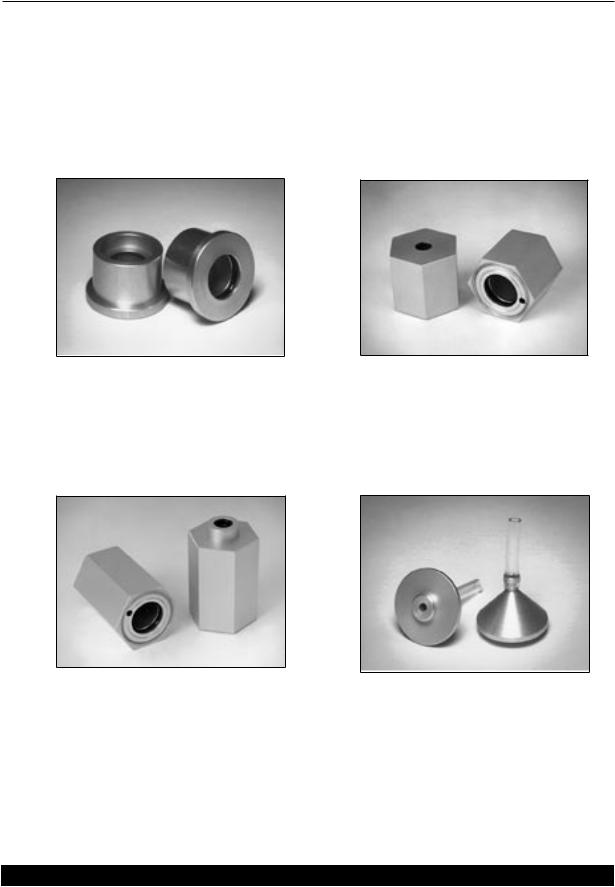
1.4 Accessories
The standard and optional accessories available for the FP40 analyzer are described in this section.
1.4.1 Standard Accessories
Microphone Adapter
14 mm to ANSI 1" diameter microphone size. This is used for calibrating the FP40 microphones.
HA-2 2-cc Coupler
Dimensions per requirements of ANSI S3.7 for testing ear level, eyeglass and body aids.
HA-1 2-cc Coupler
Dimensions per requirements of ANSI S3.7 for testing in-the-ear aids.
Ear-Level (BTE) Adapter
Snaps into the 1/4" (6.35 mm) diameter cavity in the HA-2 2-cc coupler or the MZ-2 coupler. Equipped with a 0.6" (15 mm) length of 0.076" (1.93 mm)
ID tubing, the adapter allows ANSI S3.22 specified connection of an earlevel aid to the coupler.
Introduction |
5 |
|
|

FM40 Microphone
Provided if the Real-Ear Option is not ordered.
1.4.2 Optional Accessories
6-CC Coupler
Per ANSI S3.7 for NBS 9A—used to check output of audiometers.
Battery Pills
(With 12" [30 cm] cables — 24" [60 cm]) cables available upon request) #13, #675/65, #312, #10A/230. (All pills optional with FP40-D).
Operator’s Manual
Sound Level Calibrator
For microphone calibration
6 |
FONIX FP40 Portable Hearing Aid Analyzer |
|
|
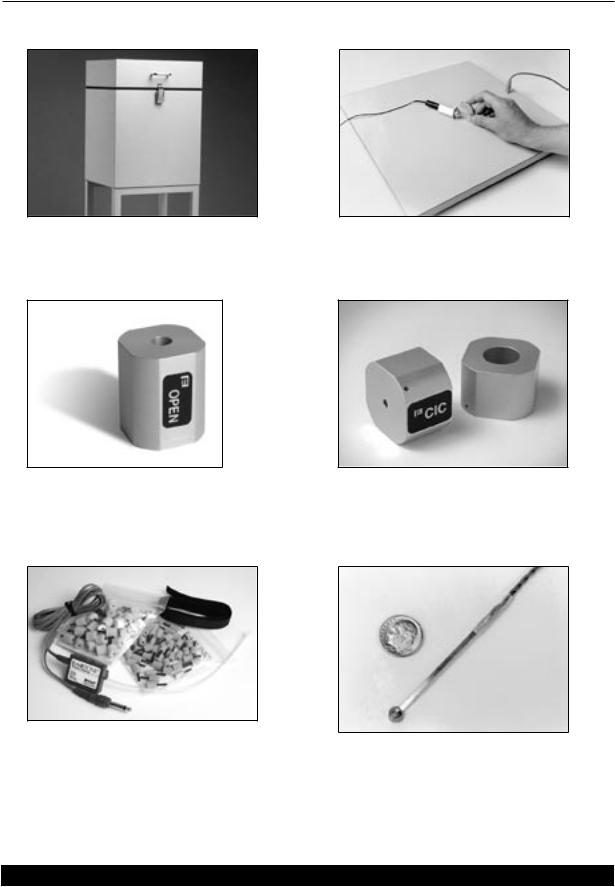
6040 Sound Chamber
For control of external noises.
Open Ear Coupler
Non-standard coupler used for realistic testing of open ear hearing aids.
RECD Earphone Package
Consists of one ER3A earphone with a phono plug, a 72 inch cable, an assortment of ear tips, a calibration certificate, and a lapel clip. This package is suitable for performing an RECD measurement with the FP40 analyzer.
External Telecoil
For checking the response of aids in the “telephone” mode.
CIC Coupler
Required coupler for use with CIC Option.
#5 Battery Pill
12" or 24"
Needed for some CIC hearing aids.
Introduction |
7 |
|
|

Child Size Wedge Style Earhook
Holds probe and reference microphones during real ear testing.
Other Optional Accessories
Telewand
For checking the telecoil response per ANSI-S3.22-1996
•RS232 Option—RS232 cable
•Probe Extension Cable for 6040 & FP40 w/o Probe
•6040 Sound Chamber Cable
•External Printer Package: serial-to-parallel converter, printer cable and custom cable •Y adapter for using both external printer and RS232
•Eartips for insert earphones:
Eartips, 3A medium, 50/pk Eartips, 3B small, 50/pk Eartips, 3C large, 25/pk
•Battery Pills, #AA, #41 (with 12" cables. 24" cables available upon request) •Maintenance Manual (on request at time of purchase
1.4.3 Real-Ear Accessories
M200 Probe Microphone |
Mounting Sleeves |
|
(L) for reference mic |
|
(R) for probe mic |
8 |
FONIX FP40 Portable Hearing Aid Analyzer |
|
|
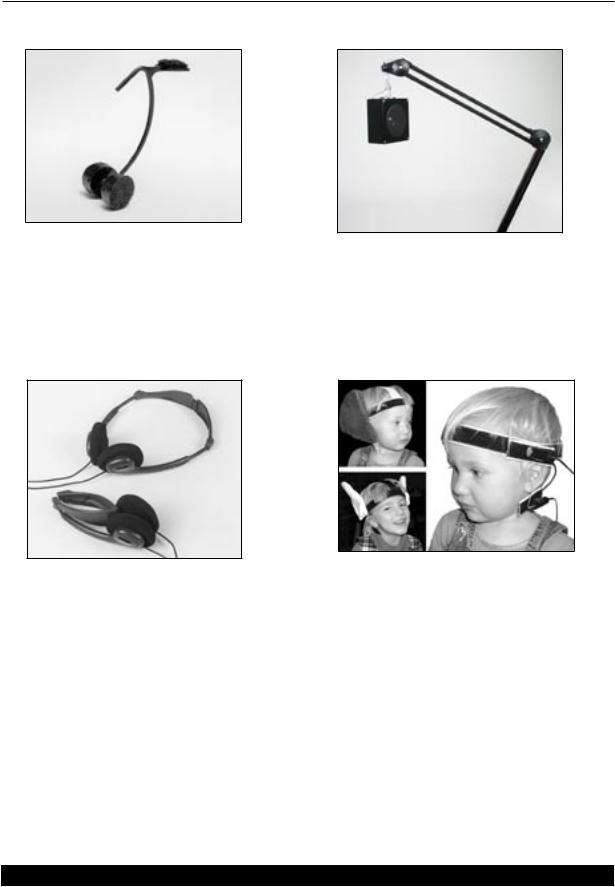
Wedge Style Ear Hook
Standard size
Holds probe and reference microphones during real ear testing. Improved design eliminates need for Velcro headband.
Monitor Headset, folding
(Optional with FP40-D)
Other Real Ear Accessories
Set of 25 Probe Tubes
Ear hook, standard size
Ear Hook, children’s size
Velcro Headband
Calibration Clip
Felt Pen-dry erase
Probe Calibration Adapter
Optional Swing Arm, Speaker, and Cable
Allows precise placement and aiming of the loudspeaker.
Infant/Child Headband Package
Includes infant, child, and adult headbands, six flexible earhooks, and two sets of “animal ears.”
Introduction |
9 |
|
|
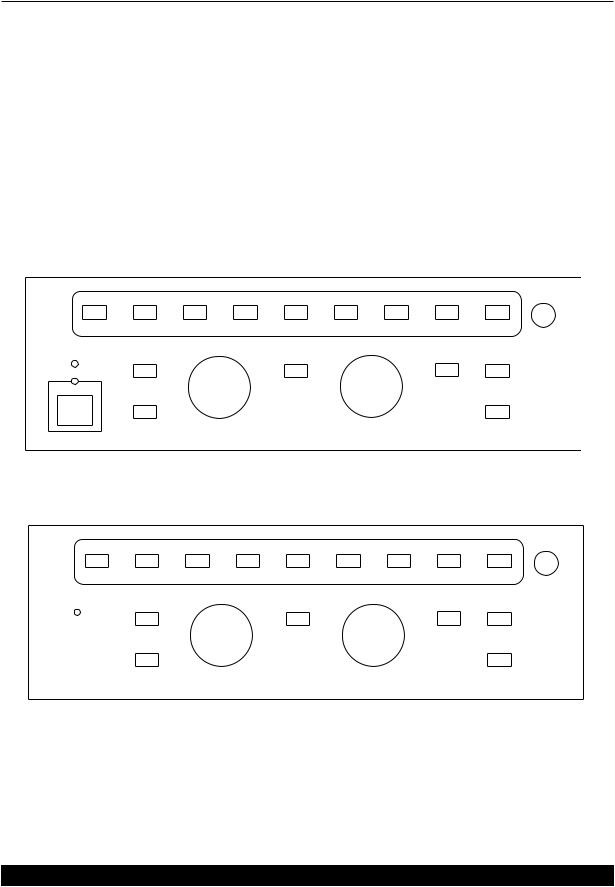
1.5 Layout & Controls
This section gives a short explanation of the layout of the FP40 analyzer, its controls, and its functions
1.5.1 LCD (Liquid Crystal Display)
The FP40 is equipped with an LCD screen that displays test results and operational instructions in both alphanumeric and graphical formats. This display is mounted on a swing-up door that can be adjusted for optimum viewing by the operator.
Hint: If no display appears on the LCD screen, turn the contrast knob in the upper right corner, or press any key.
F1 |
F2 |
F3 |
F4 |
F5 |
F6 |
F7 |
F8 |
F9 |
|
|
|
|
|
|
|
|
CONTRAST |
LINE POWER |
|
|
|
|
|
|
|
|
|
RESET |
|
|
START/ |
|
|
DATA/ |
|
OPERATE |
|
|
|
STOP |
|
|
GRAPH |
|
|
|
|
|
|
|
|
|
LEVEL
AMPLITUDE FREQUENCY
FEED
Figure 1.5.1A—FP40 Front Panel Function Buttons
F1 |
F2 |
F3 |
F4 |
F5 |
F6 |
F7 |
F8 |
F9 |
|
|
|
|
|
|
|
|
CONTRAST |
POWER |
|
|
|
|
|
|
|
|
|
RESET |
|
|
START/ |
|
|
DATA/ |
STOP |
GRAPH |
|
LEVEL
AMPLITUDE FREQUENCY
FEED
Figure 1.5.1B—FP40-D Front Panel Function Buttons
10 |
FONIX FP40 Portable Hearing Aid Analyzer |
|
|

1.5.2 Front Panel Buttons
There are nine function key buttons in the top row of the FP40 front panel. The function of each of these keys changes as you move from screen to screen on the FP40.
The rest of the front panel buttons have specific functions that do not change with each new menu selection.
Feed Feeds the paper through the printer.
Print Produces a hard copy of the data and graphs displayed on the LCD screen or monitor screen.
Data/Graph |
Allows the screen presentation to be switched from graph to data table and |
|
back again. |
Start/Stop |
Starts or continues or stops a measurement action, depending on the particular |
|
measurement task. When the instrument is running a continuous measure- |
|
ment, this button starts or freezes the measurement on the display. START/ |
|
STOP is also used to activate a menu selection. |
|
FP40s manufactured prior to 8/22/90 are marked START/CONTINUE. |
Level |
Along with START/STOP button, initiates a leveling action that takes a |
|
response measurement and develops a set of frequency response corrections to |
|
adjust the signal so that it is at the correct level for each test frequency. |
Reset |
Resets the test signal to the amplitude and frequency you have chosen in the |
|
SETUP MENU and interrupts current operation. |
Operate |
Starts and terminates the measurement operation of the FP40. Use operate to |
|
turn the instrument on and off. (There is no operate button on the FP40-D.) |
1.5.3 Front Panel Lamps
Line Power Signals that the FP40 is connected to the power line, and that the main rear panel-mounted power switch is switched “on.” If the Battery Option is installed, this lamp may also indicate that the battery is being charged.
Operate |
When lighted, signals that the instrument is active. (Not on the FP40-D). |
Introduction |
11 |
|
|
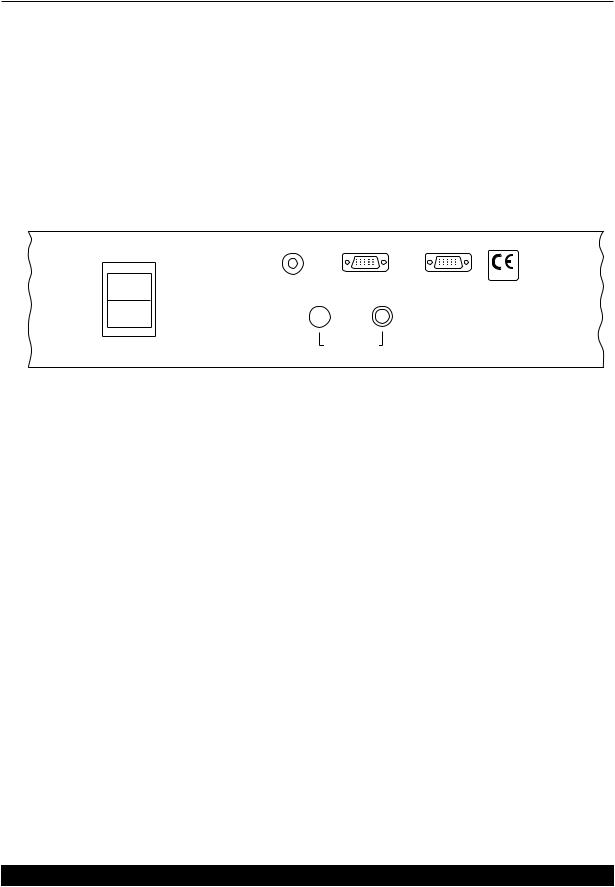
1.5.4 Front Panel Knobs
Amplitude Controls the amplitude or loudness of the test signal. Is also used to move the cursor up and down in making menu selections.
Frequency Controls the frequency of the test signal in pure-tone mode. Is also used to move the cursor left and right when making menu selections. In the real-ear target screen, it selects the amplitude in the audiogram tables.
Contrast Control Controls the contrast of LCD display. If no display appears, check this control first.
EXTERNAL |
VIDEO MONITOR |
POWER |
|
|
EXTERNAL |
|
SPEAKER |
ON
OFF
HEADPHONES
0086
SERIAL
INTERFACE
CAUTION
ELECTRICAL SHOCK HAZARD.
DO NOT REMOVE INSTRUMENT COVER. REFER SERVICE TO QUALIFIED PERSONNEL.
Figure 1.5.5—Rear Panel
1.5.5 Rear Panel Controls
External Speaker A miniature phone jack that allows an external sound field speaker or sound box (FONIX 6040) to be connected to the speaker drive from the FP40.
Headphones |
A standard 1/4 inch phone jack and volume control that allows the monitoring |
|
of the sound reaching the probe microphone. |
Serial Interface |
Nine pin D jack for RS232 connection and laser printer connection. |
CE Mark |
This symbol indicates that Frye Eelctronics conforms to the Medical Device |
|
Directive 93/42/EEC. If an external monitor or printer is used, it should also |
|
have a CE mark in order for the FP40 to remain compliant. |
Video Monitor |
Units with serial numbers 940000 and above have VGA connectors. Older units |
|
have RCA jacks for composite monitors. |
External Power |
Main power input switch. (On the portable version, operate button on front |
|
panel must also be pushed to activate the instrument.) |
12 |
FONIX FP40 Portable Hearing Aid Analyzer |
|
|
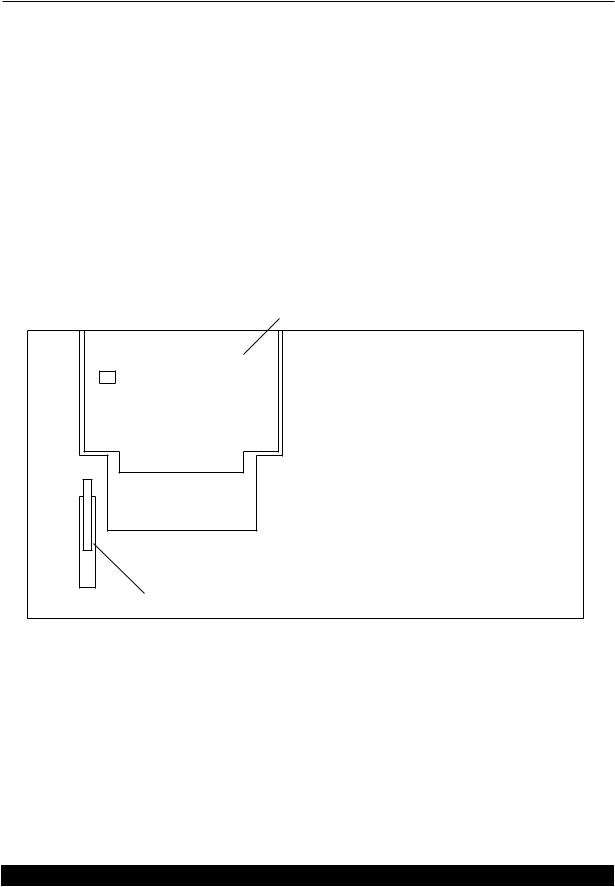
1.5.6 Right Side Mounted Jack and Module
Line input connector, IEC computer variety. Dual “snap in” fuse holder.
Instrument will automatically choose the proper voltage.
1.5.7 Sound Chamber Mounted Jacks and Controls
Jacks |
Battery replacement pill jack. Microphone jack. |
Controls |
Gain controls for microphones. |
|
Found on the left side of the sound chamber, near te speaker. |
|
Marked: Probe Gain and Ref. Gain. |
1.5.8 Top of Instrument, Printer
Printer Door
Paper Release Lever
Figure 1.5.8—Electronics Module Top View
Introduction |
13 |
|
|
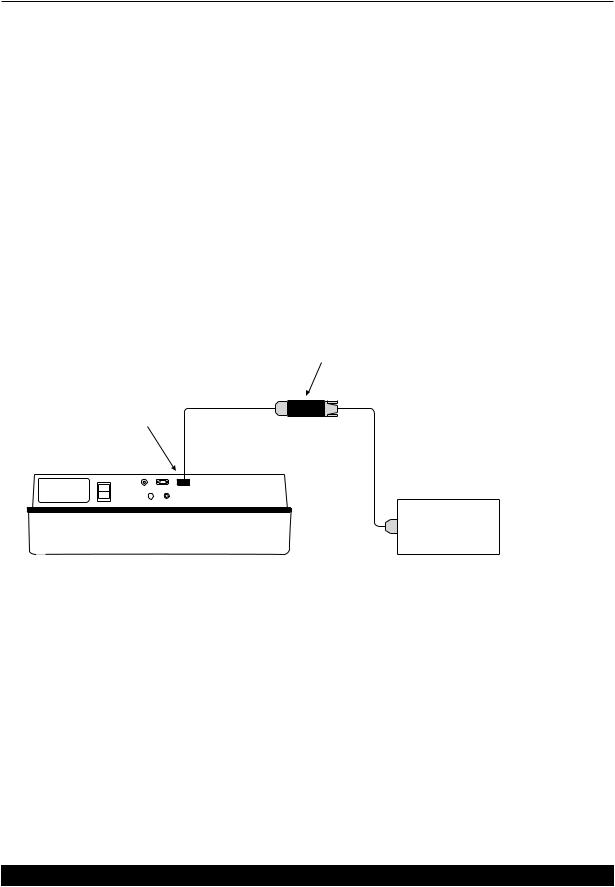
1.6 FP40 Setup
This section describes how to set up the FP40 analyzer and prepare it for testing.
1.6.1 Setting up the instrument
Unpack and locate all accessories (in the lid/FP40; in the boxes/FP40-D). Save the shipping box in case you need to send the unit in to us for repair or major upgrades. Choose a location for the FP40 which is relatively free of ambient sounds and vibrations. See Figure 1.5.5 for a drawing of the rear panel
1.6.2 Connecting equipment
If you want to connect an external printer, you must have the External Printer Kit. This kit consists of a special serial-to-parallel converter, a printer cable, a couple connectors, and an RJ11 cable. See Figure 1.6.2.
SERIAL-TO-PARALLEL
CONVERTER
SERIAL INTERFACE
|
EXTERNAL |
FONIX FP40 |
PRINTER |
Figure 1.6.2—External printer setup
1.Make sure the FP40 is turned off.
2.Attach the connector labeled “FP40 Printer” to the serial interface connector on the back of the FP40.
3.Attach the RJ11 cable to the FP40 printer connector
4.Attach the connector labeled “Printer” to the other end of the RJ11 cable.
5.Attach the printer connector to the “RS232” side of the serial-to-parallel converter.
6.Attach the printer cable to the “Parallel” side of the serial-to-parallel converter.
7.Attach the other end of the printer cable to your external printer.
14 |
FONIX FP40 Portable Hearing Aid Analyzer |
|
|

If desired, plug in an external video monitor to the connector labeled “Video Monitor” on the back of the FP40.
You can also plug in an external sound chamber or an external sound field speaker into the “external speaker” jack of the FP40.
Hint: When something is plugged into the external speaker jack, the sound source of the FP40 is always delivered to that external source, regardless of whether you are performing a coupler test or a real-ear test.
1.6.3 Connecting the line cord
Plug the line cord into the jack on the right side of the analyzer. Push the on-off rocker switch on the back of the unit. The green LED labeled “line power” (FP40) or “power” (FP40-D) will light up. This will turn on the analyzer if you have an FP40-D model. To fully turn on an FP40 model analyzer, push the square gray button marked OPERATE on the front panel.
1.7 Miscellaneous
This section describes how to clean and service your FP40 analyzer. Warranty information is also included.
1.7.1 Servicing Your FP40
Contact Frye Electronics, Inc., Box 23391, Tigard, Oregon 97281-3391 for service. Our toll-free number is 1-800-547-8209. Our regular number is (503) 620-2722, or you may contact your local Frye representative. We are also available on the internet. Our e-mail address is: service@frye.com, and our web site is http://www.frye.com.
Units may be returned to Frye Electronics, Inc., 9826 S.W. Tigard St., Tigard, Oregon 97223. It is advisable to contact the company or your local Frye representative first, since many problems can be fixed without returning the whole unit. Printed circuit boards, for instance, may be exchanged. If something must be returned, an RMA number will be issued.
When contacting the factory, please have the serial number of your instrument on hand. (Found on the rear panel of the instrument.) It will also be helpful for you to be able to tell us the software version installed on your machine. The software version and date of release are found on the LCD when you turn the unit on (FP40-D) or press OPERATE (FP40).
1.7.2 Cleaning the FP40 Display
Cleaning of the FP40 LCD screen should be kept to a minimum to avoid scratching the surface. To clean the LCD, first blow off any loose dust. Then wipe gently with a soft cloth moistened with glass cleaner. The surface of the LCD is waxed to minimize scratching.
Introduction |
15 |
|
|

1.7.3 Emergency Shutdown
If you find it impossible to turn off the instrument using the OPERATE button in units with a Battery Option, hold OPERATE down and then tap RESET twice. Or you can simply hold the OPERATE button down for five seconds.
1.7.4 Warranty
The FONIX FP40/FP40-D and its accessories are guaranteed to be free from manufacturing defects which would prevent the products from meeting these specifications for a period of one year from date of purchase.
Battery pills are warranted for thirty days because they are necessarily fragile and can be damaged by careless handling.
16 |
FONIX FP40 Portable Hearing Aid Analyzer |
|
|

Chapter 2: General Operation
This chapter discusses the general operation of the FP40 analyzer. You will learn how to navigate through the different screens, use the General Setup Menu, and change the function keys to suit your purposes. Other general operational topics will also be discussed such as source types, battery pills, printers, and other topics.
2.1 Screen Navigation
You move through the different screens of the FP40 by using the function keys. The function keys are the top row of buttons of the FP40 front panel labeled F1 through F9. Each button is labeled on the display screen just above the function keys.
For example, in most screens, F1 is labeled “MENU.” This means that you get to the Menu by pressing F1.
Hint: Whenever a function key is labeled with large letters, it is a navigational key. That is, pressing it will take you to a different screen.
2.2 General Setup Menu
In the General Setup Menu, you can change most of the settings on the FP40. To enter the General Setup Menu, press F1 from almost any screen.
Figure 2.2—General Setup Menu
General Operation |
17 |
|
|

2.2.1 Making selections
Notice the three columns in the General Setup Menu. Move the selection indicator (lines above and below the selection) from one column to another using the FREQUENCY knob. Move the knob slowly. You will feel each position change. Move the selection indicator up and down within the columns with the AMPLITUDE knob.
Push the START/STOP button, found in the very center of the front panel, to switch between the available choices at the indicated position.
2.2.2 Saving changes
Unless you purposely make setup changes permanent, they will only be effective until you turn off the analyzer. When the analyzer is turned on again, it will revert to default settings. However, you can change the default settings to suit your own needs.
•To change the default setting of an individual item, highlight the item in the General Setup Menu, change it to the desired setting, and press F8. This will store the individual item setting.
•To set the default settings of the entire menu at once, make any desired changes in the General Setup Menu, and press F9. This will store the entire menu.
2.2.3 Switching between partial and full menus
Not all the items in the General Setup Menu will apply to every screen of the FP40. In order to avoid information overload, the FP40 has a “Partial Menu” mode.
If the FP40 is in PARTIAL Menu mode, it will only display the items of interest to the screen you just left. For instance, if you enter the General Setup Menu from the Main Coupler Screen, the partial menu will not display Probe Settings. Also, if you have selected a composite signal source, it will not display the pure-tone settings.
When the FP40 is in FULL Menu mode, it will display all available settings, regardless of the screen that you just left or the signal source you have chosen.
To switch between Partial Menu mode and Full Menu mode, select MENU TYPE in the General Setup Menu. Choose between FULL and PARTIAL.
18 |
FONIX FP40 Portable Hearing Aid Analyzer |
|
|

2.3 Using Function Keys
The front panel of the FP40 analyzer contains nine function keys, F1 through F9. These keys control the navigation through the FP40 screens as well as some settings in each screen.
2.3.1 Hints
The first thing you need to understand when working with the FP40 is the concept of “function keys.” In order to make it easier to add new functions and screens to the FP40, we made the function of keys F1 through F9 vary, depending upon the current screen and your current settings. Here are three simple things to remember about function keys:
•The function of the keys vary, depending upon the current screen
•The labels above the keys always indicate the function of that key. They are never labels for the current screen.
•Small labels indicate the function key toggles a setting. Large labels indicate the function key will take you to a different screen.
These three points are explained in more detail below.
Varying Function Keys
The function of the keys vary, depending upon the current screen. There are nine function keys used on the FP40 to toggle common settings and switch between screens. We’ve tried to make the function of each key be as consistent as possible when you switch from screen to screen.
For example,
•F1 is generally the “MENU” key. Pressing it will usually take you to the General Setup Menu.
•F4 in the Main Coupler Screen will take you to an automated test sequence such as ANSI. F4 in the ANSI Screen will exit you back to the Main Coupler Screen.
The function of each key for each screen is clearly labeled above the function key on the display.
Function Key Labels are NOT Screen Labels
As mentioned above, the function of each key is labeled on the display above the key. This label always denotes the function of the key. Function key labels are never labels for the current screen.
Sometimes it’s easy to see “PROBE” above F5 and think that you are in the probe screen. Remember that the label above F5 actually means that you need to press F5 in order to enter the Probe Screen. The actual labels for the screens can usually be found in the top center of the screen.
Small Labels vs. Big Labels
There are two main types of function keys: setting keys that change a common setting in the current screen, and directional keys that take you to a different screen. In order to easily differentiate between the two types of keys, we generally use small letters to denote a setting key and large letters to denote a directional key. There are a couple of exceptions to this rule, but not many. Here’s an example from the Main Coupler Screen:
General Operation |
19 |
|
|
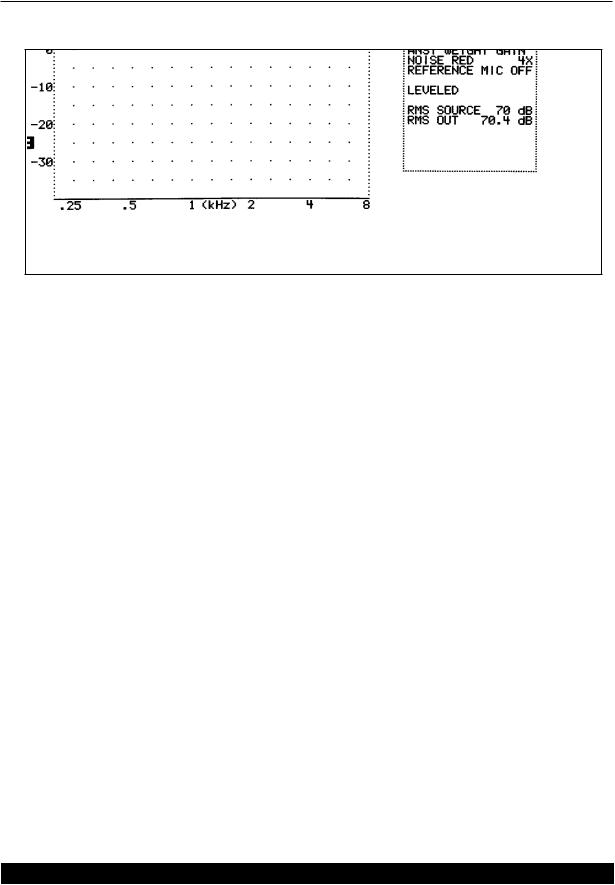
Figure 2.3.1—The Main Coupler Screen
Notice that F1, F4, and F5 are written in large letters. They take you to the Menu, ANSI 96, and Probe Screens, respectively. F2, F3, F6, F7, and F9 are all settings that pertain to the current Main Coupler Screen.
2.3.2 Customizing the function keys
As described in Section 2.3.1, the functions of F1 through F9 will vary, depending upon the current screen. Most of the time, the functions of these keys in each screen are set at the factory and cannot be changed. However, the FP40 does allow you to customize the function of several keys. This allows you to change the FP40 screen to fit your testing needs. Most of these are set in the FUNCTION KEY DEFIN section of the General Setup Menu.
MAIN F2 & MAIN F3: These settings change the function of F2 and F3 in the Main Coupler Screen. Usually, you can select from AVG, GAIN, MULTICURVE, and TELECOIL. (These options are explained in Chapter 3.) The available settings are dependent upon the options on your FP40, so you may have some additional functions available.
MAIN F4: This setting changes the automated coupler test sequence available from the Main Coupler Screen. Depending upon the options you purchased with your FP40, you may have only one choice for this key, or you may have multiple choices. See Chapter 4 for more information on automated test sequences.
SETUP F2 & SETUP F3: These selections allow you to customize the function of F2 and F3 in the General Setup Menu. This allows you to adjust functions used in the Main Coupler Screen that you might not need to change often.
For instance, if you always want to have Multi-Curve turned on in the Main Coupler Screen, you can have it set to ON in the General Setup Menu, freeing up either F2 or F3 in the Main Coupler Screen for a more commonly changed function, such as CIC.
20 |
FONIX FP40 Portable Hearing Aid Analyzer |
|
|

Note: If you toggle a function with SETUP F2 or SETUP F3, that function will remain in that setting until you explicitly change it back or turn off the analyzer. For example, if you were to: 1) Choose MULTICURVE for SETUP F2, 2) Turn MULTICURVE ON using the F2 button in the General Setup Menu, 3) Choose CIC for SETUP F2, then Multi-Curve would remain ON in the Main Coupler Screen even though it would no longer be the selection for SETUP F2.
F7 DEFINITION: This selection is in a different section in the General Setup Menu than the previously described selections. This is because MAIN F2-F4 and SETUP F2-F3 all affect the Main Coupler Screen. F7 DEFINITION, located in the PROBE SETTINGS section of the General Setup Menu, affects the F7 key in the Main Probe Screen. A setting of SOURC SEL will make F7 in the Main Probe Screen toggle between the different source types available on your FP40. This is handy when you’re doing a real-ear test, and you need to be able to quickly switch your source type. For example, you may want to switch between a composite signal and a digital speech signal. A setting of SNGL TONE allows you to present a single pure-tone signal to the aid (instead of running an entire pure-tone sweep).
2.4 Source Types
There are two main types of sources available on the FP40 analyzer: pure-tone and composite. Three kinds of pure-tone sweeps come standard with the FP40: normal, fast, and short. When you purchase the Composite Option, you will receive the Composite, Digital Speech ANSI, and Digital Speech ICRA signals.
The type of source you should choose for a particular test or type of hearing aid depends upon the signals you have available and the situation. Here is a description of each of the source types and when you would want to use them.
2.4.1 Understanding Pure-tone signals
A pure-tone sweep is a test involving a progression of pure tone signals presented at a specified level. When the sweep is complete, the aid’s frequency response at those frequencies is displayed on the graph (or data column).
There are three types of pure-tone signals: normal, fast, and short.
•NORMAL: Contains 43 different frequencies and only does one sweep before ending the test.
•FAST: Contains 16 different frequencies and continually sweeps through them until you stop the test. The fast sweep is meant to be used as a real-time continuous signal convenient for use while adjusting hearing aids. It is an alternative to the composite signal.
•SHORT: Contains 10 different frequencies and only does one sweep. It is primarily used for testing loud levels in real-ear measurements.
General Operation |
21 |
|
|

2.4.1.1 Pure-tone settings
There are several different settings available in the General Setup Menu for pure-tone signals. Here is an explanation of those settings.
RESET FREQ: The frequency the analyzer returns to when RESET is pressed.
NOISE REDUC: The amount of noise reduction used in pure-tone measurements. See Section 2.4.1.2.
SETTL. TIME: The amount of time each tone is presented before the measurement is made. See Section 2.4.1.3.
AVG FREQS: The frequencies used with the AVG function that averages the responses of three different frequencies. Each frequency set is represented on the screen by the highest frequency in the set. The sets are:
HFA (High Frequency Average) |
- 1000, 1600, 2500 |
||
SPA (Special Purpose Aids) |
- |
800, 1250, 2000 |
|
SPA |
|
- 1250, 2000, 3150 |
|
“ |
“ |
- 1600, 2500, 4000 |
|
“ |
“ |
- 2000, 3150, 5000 |
|
IEC– (HAIC) |
|
- |
500, 1000, 2000 |
DISTORTION: The type of harmonic distortion display.
DIST TYPE: Type of harmonic distortion tested. See Section 2.4.1.4.
SWEEP TYPE: Type of pure-tone sweep used in measurements. Choose NORMAL, FAST, or SHORT.
2.4.1.2 Noise Reduction
Noise reduction is used in noisy testing environments. Pure-tone noise reduction takes several measurements at each frequency and averages those measurements together. You can select the amount of measurements and averaging in the General Setup Menu, in the PURETONE SETTINGS section, under NOISE REDUC.
Larger noise reduction numbers lead to smoother curves but increase the amount of time it takes to complete a pure-tone sweep.
2.4.1.3 Settling Time
When you are measuring with pure-tone sweeps, you are offered a choice of settling times. By this we mean that the tone source will be continued for a chosen amount of time before the measurement is made. This choice is allowed because some hearing aid circuits take a longer time than others to adjust to changes in amplitude or frequency. If the measurement is made too quickly, an artifact in testing will be created. If the measurement takes too long, the test is longer than necessary.
22 |
FONIX FP40 Portable Hearing Aid Analyzer |
|
|
